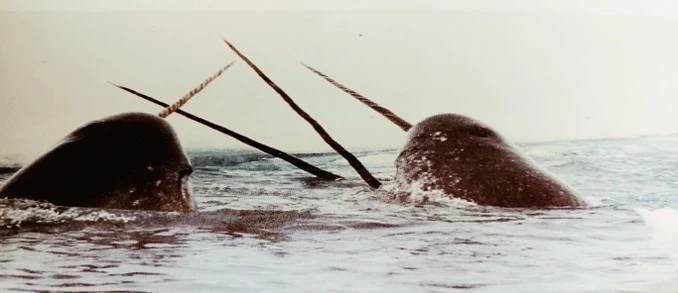The Whale, the Myth, the Legend.
, 8 July 2021
Mounted on the wall in the Clore Discovery Centre is a specimen that could have swam straight out of a mythological sea adventure. I wonder whether you’ve seen anything like it before? Could it be a unicorn horn perhaps? Many of our visitors believe so! Often referred to as the ‘Unicorns of the sea’, this tusk once belonged to a pale-coloured creature found in the Arctic coastal waters.
Narwhals (Monodon monoceros) are related to dolphins, Belugas, and Orcas. They spend their lives hanging around in the icy waters around Canada, Greenland, Norway and Russia. They winter for a very chilly 5 months under the ice and are generally spotted in groups of 15 to 20.
Narwhals feed on fish, shrimp, squid, and other aquatic fare (not that they have much choice!). Like killer whales and other toothed cetaceans, narwhals are suction feeders, meaning you might observe them tapping the fish and sucking them in, swallowing them whole. They can dive to a depth of around a mile and a half and rely on cracks in the ice above to allow them to pop up for air when needed.
The tip of the iceberg
The tusk – most commonly found on males – is actually a tooth. The spiral swordlike tusk grows right through the narwhal’s upper lip, up to 10 feet long. Some Narwhals may have two - ouch!
Scientists are not certain of the purpose of the tusk. Some believe that it is used to impress potential mates, or that they are used for battle. Recent drone footage claims to have captured a narwhal using the tusk to stun fish and some research indicates that the tusk has sensory capability, with up to 10 million nerve endings inside. What do you think their tusks are for?
Dangerous or in danger?
Narwhals and other arctic species such as polar bears and the walrus, have spent thousands of years evolving for life on and around sea ice. However, due to the effects of climate change, their ice cover is changing rapidly. Sea ice is not only a place for narwhals to feed, but also a place of refuge, providing a safe environment to hide from predators. It is shrinking far too quickly for narwhals to adapt and posing a real threat to the species.
Narwhals are also at threat from increased shipping traffic, placing them in danger of collision. Increased shipping traffic also produces a lot of underwater noise, and since whales rely on sound to communicate, noise pollution has a negative impact on their ability to find food, mates, and to avoid predators.
Our fabulous specimen is an object of wonder, but it is also a reminder of our personal and collective responsibility to ensure their survival.


